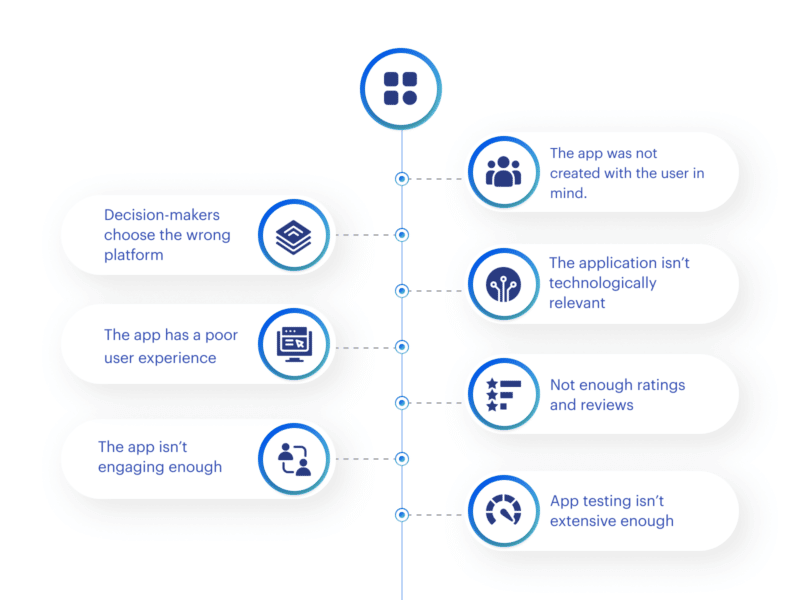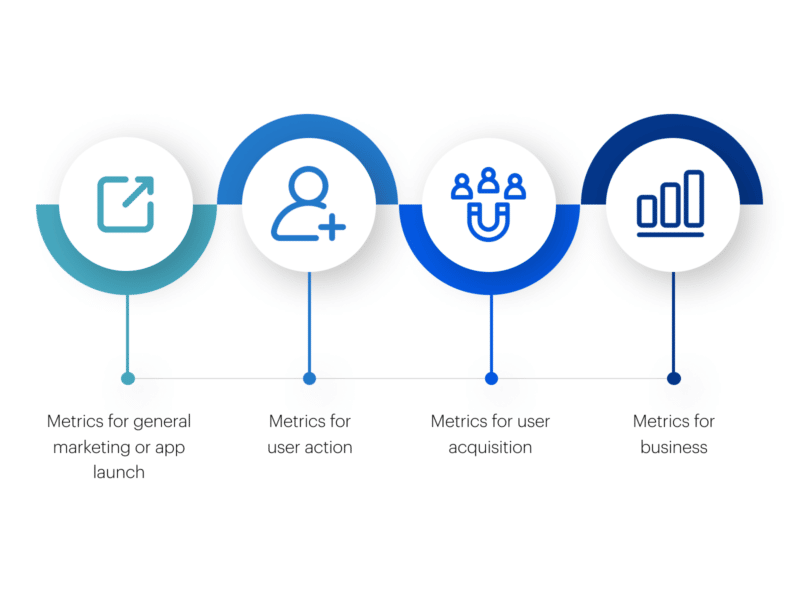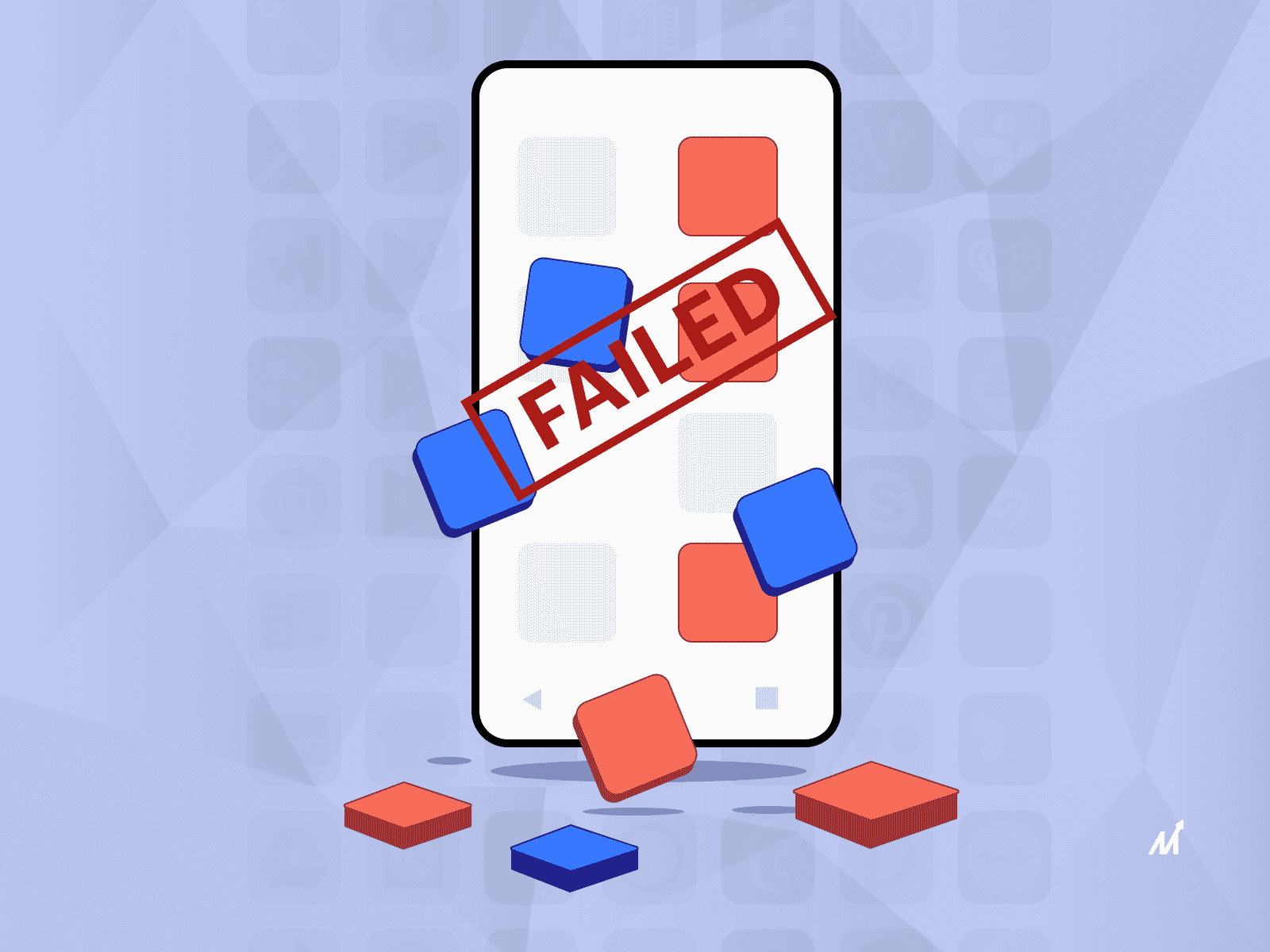Are you considering creating your mobile apps? Before getting started, here’s everything you need to know about app failure reasons.
The most difficult aspect of app development is convincing users to utilize what you’ve spent time and money developing. The following are some facts about app churn: According to Statista, 25% of consumers abandon an app after their first use, while 71% of worldwide mobile users admit to removing an app three months after downloading it.
Is it still reasonable to consider web or mobile app development a burgeoning industry?
In my perspective, we have already arrived at the pinnacle of the development of web and mobile apps, where 9 out of 10 people use a smartphone and the internet daily; in most cases, 10 out of 10, and apps are an integral part of their daily life.
Many start-ups have business concepts linked to app development, but more than 80% of them fail due to a poor strategy.
Inexperience is a simple explanation for their failure, but there are many other variables to consider before investing in or developing mobile apps for your business.
Mobile and web app development are siblings that share the same goals but work on separate platforms.
So it is reasonable to explain why they fail separately.
Why do so many mobile apps fail to succeed?
We’ve already recognized the issue, but how do you ensure your app gets the attention it deserves and doesn’t fade away after a few months?
The best strategy is to study and learn from previous app failures. To launch your app effectively, you’ll need to understand how to develop an app, the cost, and the procedure.
Without further ado, here are the top app failure reasons and what you can do to avoid following in their footsteps.

1. The app was not created with the user in mind.
Several mobile apps are doomed from the start. Why? Because they commit the fatal error of building the app without considering the user. It happens when companies don’t devote enough effort to user research.
The app design these app owners create does not appeal to their users because they haven’t unearthed their “true” wants. These apps frequently lack necessary features, handle unrelated issues, and are thus discarded.
User research must be prioritized during the app development process—this is a must. A ‘user-centered design’ mindset is one of the most effective approaches.
What exactly is user-centered design?
User-centered design (UCD) is a set of methods for putting customers at the center of product creation. When creating digital products, a product team considers the users’ needs, goals, and feedback.
User satisfaction becomes a top focus, and every design decision is assessed in terms of whether it adds value to the users. The user-centered design allows you to infuse your goods with emotional resonance.
2. Decision-makers choose the wrong platform.
The choice between iOS and Android, the two most popular mobile app platforms, is based on your target audience and the functionality you want in your app.
Because designing an Android app differs from developing one for iOS, you need carefully consider your options.
Let’s look at how the audience in a certain region could influence your choice of app platform.
Perhaps your target audience consists of users in the United States. You could then select an Android app: 53.3% of smartphone users in the United States own an Android handset, while 44.9 percent own an Apple device.
However, developing an Android app may be too expensive. Android apps are approximately 30% more expensive to build than iOS apps.
Take into account the size of the app store that represents your competition. The Google Play Store for Android has the most apps, with 3.8 million, followed by the Apple App Store, which has 2 million.
These are just a handful of the elements that may influence your choice of mobile app platform.
3. The application isn’t technologically relevant.
Mobile application development is a rapidly changing sector.
Developers and designers must keep up with current trends and use them strategically to get the most out of their projects.
Use augmented reality, for example (AR). Because of the huge success of games like Pokémon Go, augmented reality is currently quite popular.
Other industries, including education and healthcare, can also benefit from AR.
If you want to include a new trend in your app, first make sure you’re familiar with it. Using augmented reality in an app for no purpose will not please your users.
4. The app has a poor user experience.
App design entails more than just aesthetics. It’s critical to the success of your app to create a user experience that’s simple to navigate, intuitive to use, and created with the user in mind. When it comes to the user experience, there are numerous factors to consider, but let’s focus on the ones that most people overlook.
Sloppy navigation
Sloppy navigation can signify many things, and we’ve all been there. Poor navigation flow can include tapping many times to get to the target location, unclear on-screen prompts, and either too small or too wide menus.
It is the user’s worst adversary because it inhibits them from reaching their destination quickly and easily.
Poor use of icons and typography
Poor use of typefaces and icons is another aspect that impacts UX. Bad typography can make it difficult to read, and using icons incorrectly might be confusing.
If your user is having trouble comprehending what your app is trying to say, there’s a good possibility they’ll give up and move on to another app that is easier to grasp. Don’t allow a shoddy design to ruin your hard work.
Lack of search functionality
While including a search bar should be a no-brainer for a mobile app developer, it’s surprising how many do not.
Consider an e-commerce app that doesn’t have a search feature or a meal delivery service that doesn’t let users find what they’re looking for.
Unresponsive gestures
Have you ever caught tapping on the screen instead of swiping or touching an icon that doesn’t respond? You most likely have.
Unresponsive gestures are a major problem that app developers should address. It not only irritates the user but also makes your software appear amateurish.
Any of these will inevitably detract from the user’s experience. The user experience should be straightforward and fluid, and app owners and companies should prioritize this because this feature separates a successful app from a terrible one.
5. Not enough ratings and reviews.
Apps are made for those who might utilize them. You can’t expect your app to prosper if you don’t pay attention to customer ratings and feedback.
Make a good first impression because users have many options in the app store. Because 92% of users check online reviews, having a positive app is critical.
Take action if you find your app’s rating is dropping. Create an unobtrusive pop-up to solicit feedback from users.
Also, consider politely replying to unfavorable evaluations.
6. The app isn’t engaging enough.
Consider this scenario: You’ve been invited to a party, but no one has said anything to you. Alternatively, you may begin a new work and discover that no one can train you. I’m sure you’d be perplexed.
Of course, you don’t want someone attached to your hip at the party or hovering over you at work, but you do want regular check-ins from your host and encouragement from your boss.
The same goes for users who download your app—you must interact with them! You must contact out, touch base, and remind users about your software and its features.
Remember that a download only indicates interest and does not imply that the user will continue to use your app. There are also millions of free apps to choose from, including your competitors. Someone else will simply swoop in and catch your users’ attention if you don’t do your share to stay top of mind with them.
7. App testing isn’t extensive enough.
According to a Blancco survey, 58% of iOS apps crash due to insufficient testing.
It’s impossible to create a bug-free app, but it’s the developers’ obligation to test it before releasing it.
Create a complete test plan before you begin testing.
You should conduct the following sorts of testing:
-
Testing for usability
-
Feature/function testing
-
Testing for security
-
Performance evaluation
You can also use app-testing tools like Appium, Frank iOS, and MonkeyTalk.
Keep track of your results during testing to identify your app’s flaws. Keep track of the outcomes of each test you do.
If you run into problems later, you can check your testing logs to see if you’ve already addressed the problem.
Benchmarking the success of mobile apps
The build-measure-learn method is used to develop mobile apps. Your development strategy will have a long-term direction if you set success criteria and measure performance.
Success will be defined differently depending on the type of app you’re building and your overall business goals. Before you start working on your product, you should clearly know what you want to achieve.
To assess the performance of your mobile app, you must track the number of success criteria. There are four types of metrics:

1. Metrics for general marketing or app launch
-
Traffic to a website, microsite, or landing page
-
Domain authority for a website, microsite, or landing page
-
Email involvement and actions
-
Engagement and liveliness on social media
-
Mentions of brands and products
-
Backlinks to a website, microsite, landing page, or content
2. Metrics for user action
-
Intensify your sessions
-
In-app engagement/use of features
-
Boost conversion rates
3. Metrics for user acquisition
-
Increase the number of daily active users (DAUs)
-
Boost the retention rate
-
Lower the churn rate
It’s tempting to infer that user acquisition is the most important indicator for measuring the success of a mobile app launch, yet high download numbers are meaningless without engaged users.
Mobile app engagement and retention are two indicators that provide real insight into an application’s success.
Monitoring engagement and retention data will help increase the app’s lifetime value, but one of the most effective methods to assure high retention rates is incorporating a retention strategy within the product’s core experience.
4. Metrics for business
-
Boost conversion rates
-
Lower the abandonment rate
-
Product evaluations
-
Increased revenue
Monitoring the performance of your product, as well as the performance of competitors’ products, is critical.
Choosing the correct success criteria for your mobile app can help you find areas for improvement, allowing you to tweak your strategy to achieve your business and product objectives.
Checklist for launching a mobile app
As a result, we’ve covered some of app developers’ typical ideological missteps on their path to success. But, when making a mobile app launch checklist, what course-correction plan should be included?
For Android and iOS, there are different guidelines to follow. To support your transition from pre-market to post-launch, include the following stages in your app launch strategy.
Checklist for app launch
-
Conduct a quality assessment for device cross-compatibility.
-
Keep up with the latest API releases in terms of technology.
-
Plan around the Play Store listings.
-
Pre-registration can help you promote your app.
-
Upload the Android App Bundle and test it on open/closed test tracks.
-
Examine the results of pre-launch tests.
-
Define your app’s pricing and distribution regions.
-
Select appropriate distribution choices.
-
Create in-app purchases and subscriptions.
-
Set the appropriate age groups for your app’s content rating.
-
Run any remaining checks before publishing the app.
-
Further uptime quality checks will help to stabilize the app.
Conclusion
An app’s success is determined by various factors, including competition, marketing expenditures, and pure luck. However, inadequate research and procedure execution are common causes of mobile app failure in addition to these variables.
Market and audience research, platform-specific best practices, and extensive quality assurance testing can differentiate success and failure.
Any popular app did not become popular overnight. Most well-known mobile apps, such as Uber, Spotify, and Netflix, began small and evolved to become industry giants.
Likewise, if you want to survive and thrive in your specialty, start small and deliberately scale up.
We can give business owners a competitive advantage with our mobile app development services. Fill out the contact form to get in touch with our mobile app development team.

I’m Rajeev Sharma, Co-Founder and CEO of Markovate, an innovative digital product development firm with a focus on AI and Machine Learning. With over a decade in the field, I’ve led key projects for major players like AT&T and IBM, specializing in mobile app development, UX design, and end-to-end product creation. Armed with a Bachelor’s Degree in Computer Science and Scrum Alliance certifications, I continue to drive technological excellence in today’s fast-paced digital landscape.







